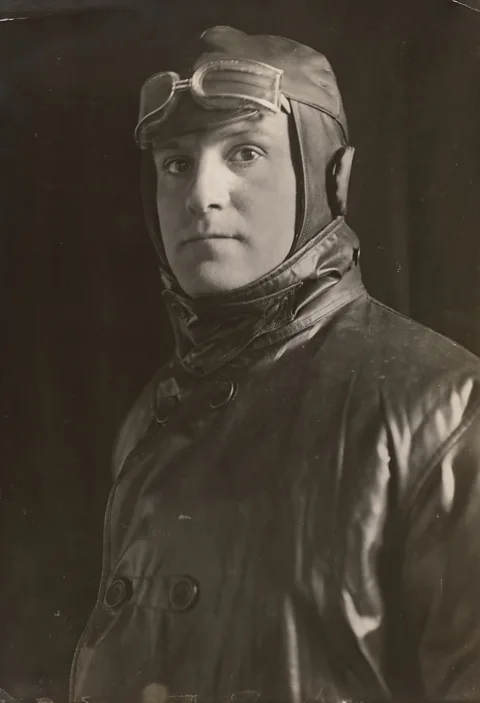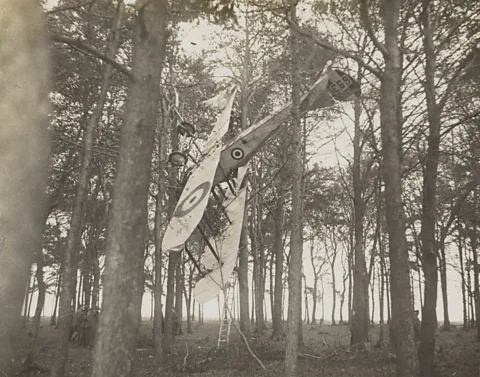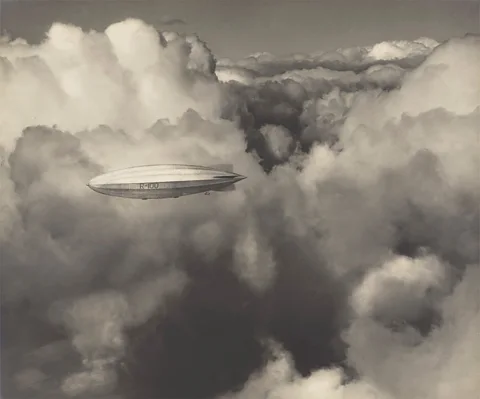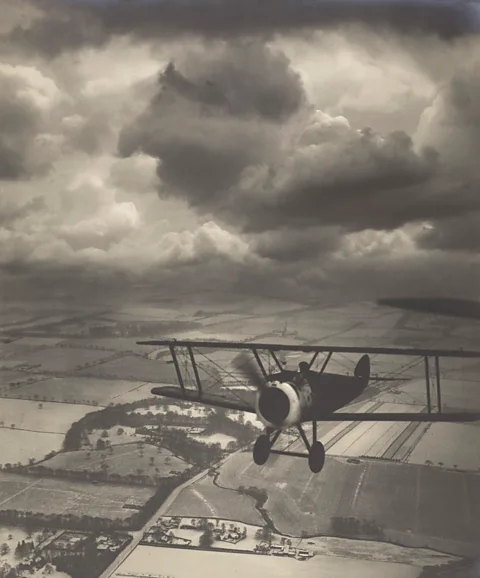'There was no holding on': The trail-blazing aerial photos of a daredevil WW1 pilot
 Collection of Richard and John Buckham
Collection of Richard and John BuckhamHaving survived nine crash landings, aviator Alfred Buckham created some of the earliest and most awe-inspiring bird's-eye images. To achieve them, he risked his life, employing perilous, death-defying acts of ingenuity.
"What scenes of Grandeur and Beauty!" exclaimed Thomas Baldwin in his 1786 account, Airopaidia, of a balloon journey over Chester during which he created one of the earliest aerial drawings. Everything was "brought up in a new manner to the eye… The imagination… was overwhelmed". Today, we take aerial views for granted. The advent of drones has popularised amateur aerial photography, while tools such as Google Earth supply bird's-eye views in seconds. However, in the Victorian era, aerial images were the result of extraordinary acts of ingenuity involving hot air balloons, pigeons, and even rockets.
 Collection of Richard and John Buckham
Collection of Richard and John BuckhamBut a new and exciting way of taking to the skies was just around the corner, as goggles were donned for the first forays into aviation. This emergent industry, coupled with the outbreak of World War One – where mapping and intelligence gathering became mission-critical – offered radical new possibilities for aerial photography. One remarkable pioneer was fearless World War One aviator Alfred Buckham (1879-1956), an irrepressible risk-taker who survived nine crash landings. Though the last of these resulted in a serious throat injury that required a laryngectomy and reduced his voice to a whisper, he continued to take to the air, combining his love of flying with his passion for photography, leaning perilously out of aeroplanes to capture some of history's earliest and most awe-inspiring aerial photographs.
His death-defying images are the subject of a major new exhibition, Alfred Buckham: Daredevil Photographer, at the Scottish National Portrait Gallery in Edinburgh. The exhibition shares Buckham's dramatic perspective on landmarks in Britain and the Americas, from the snaking, sun-streaked path of the Thames in The Heart of the Empire (1923), loaned from the V&A, to newly completed monuments such as the Empire State Building in New York and the Christ the Redeemer statue in Rio de Janeiro, both photographed for Fortune magazine during a series of flights in 1931 of record-breaking length. More than 100 photographs and objects are on display, including Buckham's letters, passport and camera – all telling the story, voiced by his grandson Richard, of his madcap aerial adventures and innovative post-production.
 Collection of Richard and John Buckham
Collection of Richard and John Buckham"I think people will enjoy getting to know him as a person who had this amazing attitude to life and to flying," the show's curator, Louise Pearson, tells the BBC. "He was this real character," she adds, who "didn't seem to register some of the danger". Airmen like Buckham, whose life expectancy was typically measured in weeks, made huge sacrifices for the war effort, flying in flimsy planes made of timber and Irish linen, with slim chances of surviving any impact. Nevertheless, Buckham made light of his brushes with death, recounting one particular close call in The New York Times Magazine in 1930: "I was head foremost in a particularly wicked bush, which was doing its best to indicate the intrusion was unwelcomed," he recalled. "But when I endeavoured to extricate myself, it became particularly cantankerous; and what I called that bush none but myself will ever know."
Buckham grew up in South London, where he married his wife Grace Marianne, and taught photography. Shortly after the birth of their son, Stanley, he joined the Royal Naval Air Service, shouting himself hoarse training recruits to take photographs at the airbase, before transferring to active service at RAF Turnhouse (now Edinburgh Airport), undertaking risky missions as first head of aerial reconnaissance (and later promoted to captain), while feeding his creativity with compositions of a more artistic nature.
 Richard and John Buckham
Richard and John BuckhamAccording to Buckham, the best results were achieved between 60 and 80mph. There was no holding on: arms, he recommended, needed to be kept clear of the fuselage to prevent the vibrations from spoiling the image. "It's not easy to tumble out of an aeroplane unless you really want to, and on considerably more than a thousand flights I have used a safety belt only once," he pronounced in the periodical The Camerain January 1927. "I always stand up to make an exposure and, taking the precaution to tie my right leg to the seat [with a scarf or a piece of rope], I am free to move rapidly, and easily, in any desired direction; and loop the loop; and indulge in other such delights, with perfect safety."
Epic assignments
Notes on the back of the images testify to the thrilling conditions in which they were created. We learn, for example, that when he shot The Thunderstorm (1920), "the lightning was blinding and the thunder unbearably loud". He continues: "The aeroplane sometimes fell several hundreds of feet in deep air pockets. Immediately after taking this photograph our machine seemed to be on fire, and the pilot and myself experienced an electric shock."
 Richard and John Buckham
Richard and John BuckhamHis epic US assignment, described by Pearson as a "last hurrah", was also full of jeopardy. In Buenos Aires, he was nearly ejected from the plane when the safety catch broke and the door swung open while he was changing a dark slide (which protects the glass plate from light); and in Nicaragua, "a cloud of choking sulphurous gas" almost overcame him as he tried to photograph an erupting volcano. It was the extreme altitude that caused the greatest problem on a flight over the Andes, as his disability prevented him from using the oxygen tube. Anticipating periods of lost consciousness, he calmly passed a note to his pilot asking him to thrust back his head back whenever it fell forward. His stoicism was rewarded with the photo he named Over the Top: the Andes at 19,700 ft (1931), an image that feels as though we are perched upon its vast snowy peaks.
More like this:
• The disturbing story behind this iconic nude photo
The majority of Buckham's images were taken in Scotland, where he was stationed. The most famous of these is Edinburgh (c 1920), showing Edinburgh Castle rising majestically from the foreground, and Arthur's Seat cloaked in mist beyond it. Looming above is a lonely biplane, surveying the scene, from this incredible vantage point. The image will be displayed with the three glass negatives Buckham used to make it. In some ways, he was a traditionalist, preferring glass plates over the new photographic film, yet the way he created composites from them was highly modern and helped blaze a trail for current photoshopping practices and AI-created images.
 Richard and John Buckham
Richard and John BuckhamSince the sky required a shorter exposure time than land or sea, it needed to be captured separately, so Buckham made selections from his cloud library of more than 2000 skyscapes, skilfully blending the image into the central shot by lightening the exposure of some areas and darkening others. "The cloud library was crucial to what Buckham was trying to do: to make the viewers of his images – people then and people now – feel what he was feeling up in the sky," writes the presenter of the BBC's Scotland from the Sky series, James Crawford, in the exhibition catalogue's introduction. In these very early days of aviation, it was, he stresses, "an experience which… very few had shared".
Buckham admired the British landscape painter JMW Turner, and had once hoped to become a painter himself. Like his hero, creativity and emotional response was more important to him than verisimilitude. "He went into it as an artist," says Pearson, emphasising "the uniqueness of what he was doing… You can see the painterly approach, particularly in the cloud images." In Edinburgh, for example, the application of black watercolour draws our attention to the castle, while elsewhere the white paper is scratched to highlight key buildings.
On occasions, as with Sunset over the Pentlands Range (1920), he flipped photographs if he felt the mirror image looked better, and all the aircraft were photographed on land to give them the necessary sharpness. Sometimes, as in The Forth Bridge (1920), Buckham's most photographed subject, the same plane appears twice.
 Richard and John Buckham
Richard and John Buckham"It's actually quite hard to make it look realistic by getting the scale of the planes and the cloud formations right," explains Pearson. Buckham saw these edits as integral to his art-making and was open about his approach, sharing his techniques in photographic publications and lectures. "He was proudly telling his contemporaries about it," says Pearson. "He was very forward-thinking in the way he approached image-making… Each photograph to him was a unique art[work]."
Buckham's attitude to his art was almost as adventurous as his flying. With so many of his comrades lost in battle, he did not let convention or fear restrict him. Nor did he allow his disability to hold him back, making many of his most extraordinary high-altitude images in flagrant disregard of his doctor's advice. Against the odds, he lived to be 76. The challenges he faced along the way – the crashes and close calls – he viewed with a veteran's pragmatism and a dash of nostalgia. "Such unpleasing circumstances are mostly forgotten, or only serve to add spice to the remembrance," he told the New York Times Magazine in 1930. "Ah! One was a rare daredevil in those days!"
Alfred Buckham: Daredevil Photographer is at the National Portrait Gallery of Scotland, until 19 April 2026.
--
If you liked this story, sign up for The Essential List newsletter – a handpicked selection of features, videos and can't-miss news, delivered to your inbox twice a week.
For more Culture stories from the BBC, follow us on Facebook and Instagram.
